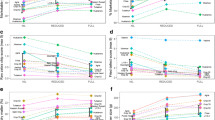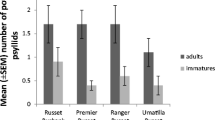Abstract
Tomato-Potato Psyllid (TPP) Bactericera cockerelli was first identified in New Zealand in 2006 and has caused major problems for the potato industry, particularly in the North Island. TPP and Zebra chip (ZC) resistance are now major priorities in Plant & Food Research’s potato breeding programme. ZC is caused by a liberibacter associated with the TPP. Twelve potato lines, including most of the more widely grown potato cultivars in New Zealand, were assessed in main-crop yield trials at Pukekohe under three insecticide levels: FULL (pre-plant plus 13–15 foliar insecticide applications through the season), REDUCED (4–5 foliar applications) and NIL (no insecticide), over two consecutive seasons’ harvest (2010 and 2011). In both years work there was a consistent substantial yield reduction from the FULL to the REDUCED insecticide to the NIL insecticide treatment. In most cases a similar trend was seen in dry matter and tuber size. ZC severity recorded in crisp slices before and after frying tended to be highest in the NIL insecticide treatment and lowest in the FULL insecticide treatment. The fresh market cultivar ‘Nadine’ had very little ZC in any raw tubers of any of the insecticide treatments in either season. Despite this the marketable yield of Nadine with NIL insecticide was almost half that of the FULL insecticide treatment in 2010 and about 60 % of the intensive insecticide level in 2011. There was no real indication that any of the other cultivars in the trial had any effective resistance to TPP or ZC.
Resumen
El psílido del tomate y de la papa (TPP) Bactericera cockerelli se identificó por primera vez en Nueva Zelanda en 2006 y ha causado grandes problemas a la industria de la papa, particularmente en la Isla Norte. La resistencia a TPP y a la “zebra chip” (ZC) son ahora prioridades mayores en el programa de mejoramiento de papa de Investigación de Plantas y Alimentos. La ZC es causada por una liberibacter asociada con TPP. Se evaluaron 12 líneas de papa, incluyendo la mayoría de las variedades de papa mas ampliamente cultivadas en Nueva Zelanda, en ensayos de rendimiento como cultivo principal en Pukekohe bajo tres niveles de insecticidas: COMPLETO (en pre-siembra, más 13–15 aplicaciones foliares de insecticida a lo largo del ciclo), REDUCIDO (4–5 aplicaciones foliares) y NADA (sin insecticidas), en dos ciclos de cultivo consecutivos de cosecha (2010 y 2011). En ambos años se presentó una reducción consistente substancial de rendimiento del nivel COMPLETO al REDUCIDO y al tratamiento sin insecticida. En la mayoría de los casos se observó la misma tendencia en materia seca y tamaño de tubérculo. Los registros de severidad de ZC en hojuelas antes y después del freído tuvieron la tendencia de ser los más altos en el tratamiento sin insecticidas y los mas bajos en el tratamiento con el nivel COMPLETO. La variedad para el mercado fresco “Nadine” tuvo muy poca ZC en cualquiera de los tubérculos crudos o en cualquiera de los tratamientos con insecticida en ambos ciclos. A pesar de esto, el rendimiento comercial de Nadine sin insecticida fue casi la mitad del tratamiento con nivel COMPLETO de insecticida en 2010 y cerca del 60 % del nivel intensivo en 2011. No hubo una indicación real de que alguna de las otras variedades en el ensayo tuviera algo de resistencia efectiva a TPP o ZC.


Similar content being viewed by others
References
Anonymous. 2009. Potato psyllid control. http://www.potatoesnz.co.nz/users/Image/Graphics/PDFS/Psyllid_November09fact_sheets_-_control_lr.pdf (accessed 30 March 2009).
Anonymous. 2011. Agrichemical update. http://www.potatoesnz.co.nz/users/Image/Downloads/PDFs/Psyllid%20News%20December%202011final.pdf (accessed 20 January 2012).
Butler, D. 2009. asreml: asreml() fits the linear mixed model. R package version 3.00.
Butler, C.D., and J.T. Trumble. 2010. Distribution and phenology of the potato psyllid in southern California. In Proceedings of the 10th Annual Zebra Chip Reporting Session, ed. F. Workneh and C.M. Rush (eds.), 37–41. Dallas, TX.
Kale, A. 2011. Report on the economic and business impacts of the potato psyllid on the potato industry. http://www.potatoesnz.co.nz/users/Image/Downloads/PDFs/Potato%20Economic%20survey%20Report%20Jun%202011_V2.pdf (accessed 1 March 2011)
Kelly, A.M., A.B. Smith, J.A. Eccleston, and B.R. Cullis. 2008. The accuracy of varietal selection using factor analytic models for multi-environment plant breeding trials. Crop Science 47: 1063–1070.
Liefting, L.W., Z.C. Rez-Egusquiza, G.R.G. Clover, and J.A.D. Anderson. 2008. A new ‘Candidatus Liberibacter’ species in Solanum tuberosum in New Zealand. Plant Disease 92: 1474.
Munyaneza, J.E., J.M. Crosslin, and J.E. Upton. 2007. Association of Bactericera cockerelli (Homoptera: Psyllidae) with “zebra chip”, a new potato disease in southwestern United States and Mexico. Journal of Economic Entomology 100: 656–663.
Munyaneza, J.E., J.L. Buchman, V.G. Sengoda, T.W. Fisher, and C.C. Pearson. 2011. Susceptibility of selected potato varieties to zebra chip potato disease. American Journal of Potato Research 88: 435–440.
Novy, R.G., J. Whitworth, J. Alvarez, J.T.Trumble, C.D. Butler, J.L. Buchman, and J.E. Munyaneza. 2010. Unique Tri-states species germplasm with multiple insect resistances and its use in breeding for resistance to psyllid/ZC. In Proceedings of the 10th Annual Zebra Chip Reporting Session, ed. F. Workneh and C. M. Rush, 103–105. Dallas, TX.
Pierson, E., C. Miller, D. Scheuring., T.X. Liu, X. Yang, J. Jifon, D. Gross, R. Aravind, and J. Levy. 2010. Investigations on putative zebra chip (ZC) tolerant advanced selections. In Proceedings of the 10th Annual Zebra Chip Reporting Session, ed. F. Workneh and C. M. Rush, 99–102. Dallas, TX.
R Development Core Team. 2011. R: A language and environment for statistical computing. R Foundation for Statistical Computing, Vienna, Austria. ISBN 3-900051-07-0, URL http://www.R-project.org.
Raman, K.V., A.M. Golmirzaie, M. Palacios, and J. Tenorio. 1994. Inheritance of resistance to insects and mites. In Potato Genetics, ed. J.E. Bradshaw and G.R. Mackay, 447–463. Oxon: CAB international.
Smith, A.B., J.K. Stringer, X. Wei, and B.R. Cullis. 2007. Varietal selection for perennial crops where data related to multiple harvests from a series of field trials. Euphytica 157: 253–266.
Teulon, D.A.J., P.J. Workman, K.L. Thomas, and M.-C. Nielsen. 2009. Bactericera cockerelli: incursion, dispersal and current distribution on vegetable crops in New Zealand. New Zealand Plant Protection 62: 136–144.
Walker, G.P., F.H. MacDonald, N.J. Larsen, and A.R. Wallace. 2011. Monitoring of tomato-potato psyllid and associated insects in unsprayed potatoes in New Zealand. New Zealand Plant Protection 64: 269–275.
Walker, G.P., F.H. MacDonald, A.J. Puketapu, H.A. Fergusson, P.G. Connolly, P.J. Wright, and J.A.D. Anderson. 2012. A field trial to assess damage by Bactericera cockerelli to early potatoes at Pukekohe. New Zealand Plant Protection 65: 148–154.
Acknowledgements
This work was largely funded by the Plant & Food Research/Potatoes New Zealand joint potato breeding programme. Funding for the monitoring of TPP was provided by the New Zealand Ministry for Science and Innovation (C06X0811) and MAF Sustainable Farming Fund Project No. 09/143.
Author information
Authors and Affiliations
Corresponding author
Rights and permissions
About this article
Cite this article
Anderson, J.A.D., Walker, G.P., Alspach, P.A. et al. Assessment of Susceptibility to Zebra Chip and Bactericera cockerelli of Selected Potato Cultivars under Different Insecticide Regimes in New Zealand. Am. J. Potato Res. 90, 58–65 (2013). https://doi.org/10.1007/s12230-012-9276-x
Published:
Issue Date:
DOI: https://doi.org/10.1007/s12230-012-9276-x




